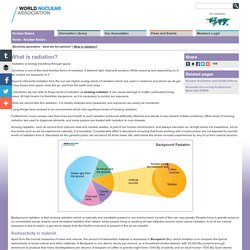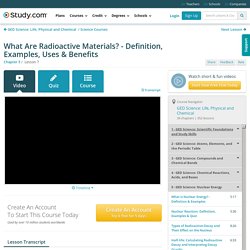

What is Radiation. Radiation is energy travelling through space.

Sunshine is one of the most familiar forms of radiation. It delivers light, heat and suntans. While enjoying and depending on it, we control our exposure to it. Beyond ultraviolet radiation from the sun are higher-energy kinds of radiation which are used in medicine and which we all get in low doses from space, from the air, and from the earth and rocks. Collectively we can refer to these kinds of radiation as ionising radiation. While we cannot feel this radiation, it is readily detected and measured, and exposure can easily be monitored.
Living things have evolved in an environment which has significant levels of ionising radiation. Furthermore, many people owe their lives and health to such radiation produced artificially. Ionising radiation, such as occurs from uranium ores and nuclear wastes, is part of our human environment, and always has been so. Radioactivity in material Ionising radiation – alpha, beta and gamma. Radioactive waste levels australia. National Radioactive Waste Management Facility. Australia's radioactive waste results from the use of radioactive materials in medicine, research and industry.

Relatively small amounts of low and intermediate level waste are produced as a result of these activities. Although currently safe, these storage arrangements are not ideal: many facilities are nearing capacity, and were not designed for storage over the longer term. As such they have no guarantee of operational continuity. Some of this waste originates from work undertaken by the Australian Nuclear Science and Technology Organisation (ANSTO). This includes gloves and disposable instruments used in the creation of nuclear medicine.
There is international expert consensus that purpose built, centralised facilities are the safest and most efficient option to manage radioactive waste. Return of Australian nuclear waste The low and intermediate level radioactive waste resulting from the reprocessing will be returned to Australia, as required under the inter-country agreements. What Is Radioactive Material and How Does It Decay? RER-20. Audeen W.

Fentiman Timothy A. Leet Joyce E. Meredith All materials are made of atoms. Radioactive atoms are unstable; that is, they have too much energy. The Atom The explanation of radioactive decay begins with a description of the atom. Figure 1. Isotopes While all atoms of the same element have the same number of protons, it is possible for atoms of one element to have different numbers of neutrons. Radioactive Decay When the nucleus of a radioactive isotope gives up its extra energy, that energy is called ionizing radiation. Decay Chain When the nucleus of a radioactive isotope decays, emitting ionizing radiation, the nucleus is altered.
Fact Sheet on Dirty Bombs. Printable Version Background A "dirty bomb" is one type of a radiological dispersal device (RDD) that combines conventional explosives, such as dynamite, with radioactive material.

The terms dirty bomb and RDD are often used interchangeably in the media. Most RDDs would not release enough radiation to kill people or cause severe illness - the conventional explosive itself would be more harmful to individuals than the radioactive material. However, depending on the situation, an RDD explosion could create fear and panic, contaminate property, and require potentially costly cleanup. A dirty bomb is in no way similar to a nuclear weapon or nuclear bomb. Impact of a Dirty Bomb The extent of local contamination would depend on a number of factors, including the size of the explosive, the amount and type of radioactive material used, the means of dispersal, and weather conditions.
Immediate health effects from exposure to the low radiation levels expected from an RDD would likely be minimal. Nuclear Basics. What Are Radioactive Materials? - Definition, Examples, Uses & Benefits. Radioactive materials are all around us.

Some are beneficial, while others may cause us harm. In this lesson you'll learn what radioactive materials are and explore where they come from and how they can be useful to us. Explore our library of over 10,000 lessons Click "next lesson" whenever you finish a lesson and quiz. Got It You now have full access to our lessons and courses. You're 25% of the way through this course! The first step is always the hardest! Way to go! Congratulations on earning a badge for watching 10 videos but you've only scratched the surface. You've just watched 20 videos and earned a badge for your accomplishment! You've just earned a badge for watching 50 different lessons. You just watched your 100th video lesson. Congratulations! Congratulations! You are a superstar! ARPANSA - Understanding Radiation.